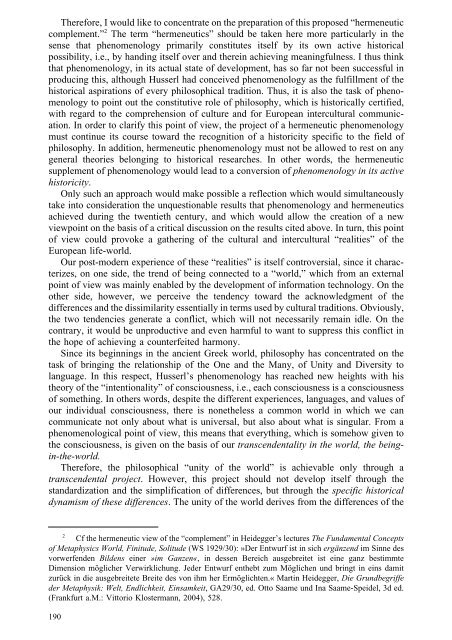[Andrzej_Wiercinski_(ed ... - WordPress.com
[Andrzej_Wiercinski_(ed ... - WordPress.com
[Andrzej_Wiercinski_(ed ... - WordPress.com
You also want an ePaper? Increase the reach of your titles
YUMPU automatically turns print PDFs into web optimized ePapers that Google loves.
Therefore, I would like to concentrate on the preparation of this propos<strong>ed</strong> “hermeneutic<strong>com</strong>plement.” 2 The term “hermeneutics” should be taken here more particularly in thesense that phenomenology primarily constitutes itself by its own active historicalpossibility, i.e., by handing itself over and therein achieving meaningfulness. I thus thinkthat phenomenology, in its actual state of development, has so far not been successful inproducing this, although Husserl had conceiv<strong>ed</strong> phenomenology as the fulfillment of thehistorical aspirations of every philosophical tradition. Thus, it is also the task of phenomenologyto point out the constitutive role of philosophy, which is historically certifi<strong>ed</strong>,with regard to the <strong>com</strong>prehension of culture and for European intercultural <strong>com</strong>munication.In order to clarify this point of view, the project of a hermeneutic phenomenologymust continue its course toward the recognition of a historicity specific to the field ofphilosophy. In addition, hermeneutic phenomenology must not be allow<strong>ed</strong> to rest on anygeneral theories belonging to historical researches. In other words, the hermeneuticsupplement of phenomenology would lead to a conversion of phenomenology in its activehistoricity.Only such an approach would make possible a reflection which would simultaneouslytake into consideration the unquestionable results that phenomenology and hermeneuticsachiev<strong>ed</strong> during the twentieth century, and which would allow the creation of a newviewpoint on the basis of a critical discussion on the results cit<strong>ed</strong> above. In turn, this pointof view could provoke a gathering of the cultural and intercultural “realities” of theEuropean life-world.Our post-modern experience of these “realities” is itself controversial, since it characterizes,on one side, the trend of being connect<strong>ed</strong> to a “world,” which from an externalpoint of view was mainly enabl<strong>ed</strong> by the development of information technology. On theother side, however, we perceive the tendency toward the acknowl<strong>ed</strong>gment of th<strong>ed</strong>ifferences and the dissimilarity essentially in terms us<strong>ed</strong> by cultural traditions. Obviously,the two tendencies generate a conflict, which will not necessarily remain idle. On thecontrary, it would be unproductive and even harmful to want to suppress this conflict inthe hope of achieving a counterfeit<strong>ed</strong> harmony.Since its beginnings in the ancient Greek world, philosophy has concentrat<strong>ed</strong> on thetask of bringing the relationship of the One and the Many, of Unity and Diversity tolanguage. In this respect, Husserl’s phenomenology has reach<strong>ed</strong> new heights with histheory of the “intentionality” of consciousness, i.e., each consciousness is a consciousnessof something. In others words, despite the different experiences, languages, and values ofour individual consciousness, there is nonetheless a <strong>com</strong>mon world in which we can<strong>com</strong>municate not only about what is universal, but also about what is singular. From aphenomenological point of view, this means that everything, which is somehow given tothe consciousness, is given on the basis of our transcendentality in the world, the beingin-the-world.Therefore, the philosophical “unity of the world” is achievable only through atranscendental project. However, this project should not develop itself through thestandardization and the simplification of differences, but through the specific historicaldynamism of these differences. The unity of the world derives from the differences of the2Cf the hermeneutic view of the “<strong>com</strong>plement” in Heidegger’s lectures The Fundamental Conceptsof Metaphysics World, Finitude, Solitude (WS 1929/30): »Der Entwurf ist in sich ergänzend im Sinne desvorwerfenden Bildens einer »im Ganzen«, in dessen Bereich ausgebreitet ist eine ganz bestimmteDimension möglicher Verwirklichung. J<strong>ed</strong>er Entwurf enthebt zum Möglichen und bringt in eins damitzurück in die ausgebreitete Breite des von ihm her Ermöglichten.« Martin Heidegger, Die Grundbegriff<strong>ed</strong>er Metaphysik: Welt, Endlichkeit, Einsamkeit, GA29/30, <strong>ed</strong>. Otto Saame und Ina Saame-Speidel, 3d <strong>ed</strong>.(Frankfurt a.M.: Vittorio Klostermann, 2004), 528.190


